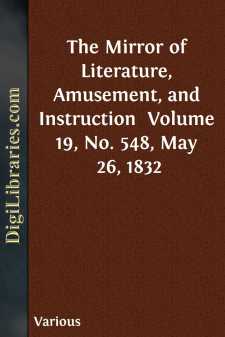Categories
- Antiques & Collectibles 13
- Architecture 36
- Art 48
- Bibles 22
- Biography & Autobiography 813
- Body, Mind & Spirit 142
- Business & Economics 28
- Children's Books 17
- Children's Fiction 14
- Computers 4
- Cooking 94
- Crafts & Hobbies 4
- Drama 346
- Education 46
- Family & Relationships 57
- Fiction 11829
- Games 19
- Gardening 17
- Health & Fitness 34
- History 1377
- House & Home 1
- Humor 147
- Juvenile Fiction 1873
- Juvenile Nonfiction 202
- Language Arts & Disciplines 88
- Law 16
- Literary Collections 686
- Literary Criticism 179
- Mathematics 13
- Medical 41
- Music 40
- Nature 179
- Non-Classifiable 1768
- Performing Arts 7
- Periodicals 1453
- Philosophy 64
- Photography 2
- Poetry 896
- Political Science 203
- Psychology 42
- Reference 154
- Religion 513
- Science 126
- Self-Help 84
- Social Science 81
- Sports & Recreation 34
- Study Aids 3
- Technology & Engineering 59
- Transportation 23
- Travel 463
- True Crime 29
The Mirror of Literature, Amusement, and Instruction Volume 19, No. 548, May 26, 1832
by: Various
Categories:
Description:
Excerpt
STAINES NEW BRIDGE.
This handsome structure has lately been completed, and was opened on Easter Monday last, April 24, by their Majesties and the Court passing over with suitable ceremony. This was a gala day for Staines and its vicinity; for, independently of the enthusiasm awakened by the visit of the popular Sovereign, the completion of so useful and ornamental a fabric must have been an occasion of no ordinary interest to every inhabitant of the district.
The programme, as the French would say, of the day's fête has been so recently given in the "chronicles of the times," that we need not repeat it. A few descriptive particulars of the Bridge, from The Times Journal, may be found to possess a more permanent value:—
"It consists of three very flat segmental arches of granite. The middle arch of 74 feet span, and the two side arches of 66 feet each; besides two side arches of 10 feet each for the towing-paths, and six brick arches of 20 feet span each, two on the Surrey side, and four on the Middlesex side, to allow the floods to pass off. The whole is surmounted by a plain, bold cornice, and block parapet of granite, with pedestal for the lamps, and a neat toll-house. The approaches to the Bridge on either side form gentle curves of easy ascent. The cost of the Bridge and approaches has been about 41,000l. The appearance of the whole is very light and elegant. This is owing chiefly to the slight dimensions of the piers, which are smaller in proportion to the span of the arches they support than those of any other bridge in England; but this slight appearance does not, we understand, detract in any degree from their strength, or from the durability of the superincumbent structure."
From the same authority we gather this circumstantial account of the Bridges erected at Staines from the year 1262:
"The first erection mentioned in the archives of Staines, was a wooden bridge, said to have been erected in the year 1262; it was constructed of piles of oak driven into the bed of the river and covered with planks. We hear of no new erection from that period down to the year 1794; but from that year to the present, there have been not less than four new bridges in succession, and on nearly the same site. In the year 1794 and 1795, a new bridge, of three semicircular arches of stone, from the design of the celebrated Paul Sandby, was erected, but, from some defect in its construction, it lasted only five years, when it was replaced by a very elegant bridge of one arch, of 180 feet span, of cast iron, from the design of Mr. Thomas Wilson, the architect of the celebrated bridge over the river Weir, at Sunderland. The design was attributed to the noted author of the Rights of Man; but the arch designed by him was cast in the year 1790, by Messrs. Walkers, at Rotherham, whence it was brought to London, and erected at the bowling-green of the Yorkshire Stingo public-house, where it was exhibited to the public; Paine not being able to defray the expense, the arch was taken down and carried back to Rotherham; part of it was afterwards used in the Sunderland bridge, and part, it is supposed, in the Staines bridge....












